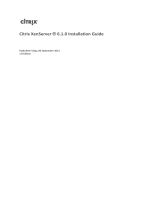
12 Overview
Citrix XenServer Dell Edition is pre-installed on PowerEdge systems.
You require a license key to enable Citrix Essentials for XenServer
Dell Enterprise Edition.
If you purchased Citrix Essentials for XenServer Dell Enterprise Edition, you
must redeem the activation code from the license card you received with your
system. You must redeem your authorization code(s) for Enterprise license
files from the Citrix Dell Edition Product Gallery website
at
citrix.com/xenserver/dell. You need to register in this website.
NOTE: To purchase a Citrix Essentials for XenServer Dell Enterprise Edition license
key, visit the Virtualization with Dell and Citrix website at dell.com/xenserver or
contact your Dell sales representative.
NOTE: If you lose the license card you received with your system, Dell cannot issue
another one. Register the product immediately and ensure that you keep the license
card in a safe location.
You may apply your Enterprise license file(s) from the XenServer local console
or XenCenter.
VM Operating System Support
XenServer VMs are created from templates. A template is a file that
contains the configuration settings to instantiate a specific VM.
XenServer Dell Edition ships with a base set of templates—some that can
boot an operating system installation media, and others that run an
installation from a network repository. For a list of supported operating
systems and installation methods, see Table 1-1.
For more information on creating VMs of the supported types, see the
XenServer Virtual Machine Installation Guide available on the Citrix
XenServer Dell Edition website at citrix.com/xenserver/dell.
Additionally, you can create VMs by importing an existing exported VM.
NOTE: The standard editions of XenServer provide two Debian templates.
Each template contains a complete basic Debian Linux distribution. Each template
also supports physical to virtual conversion (P2V) of existing instances of Red Hat
®
Enterprise Linux
®
3.6, 3.8, 4.2-4.3, and Novell
®
SUSE
®
Linux Enterprise Server 9 SP2
and SP3 operating systems. Due to space constraints imposed by the flash media
on which XenServer Dell Edition runs, you cannot create VMs of these types with
the XenServer Dell Edition. However, you can import instances of VMs created and
exported with the standard edition of XenServer.






















